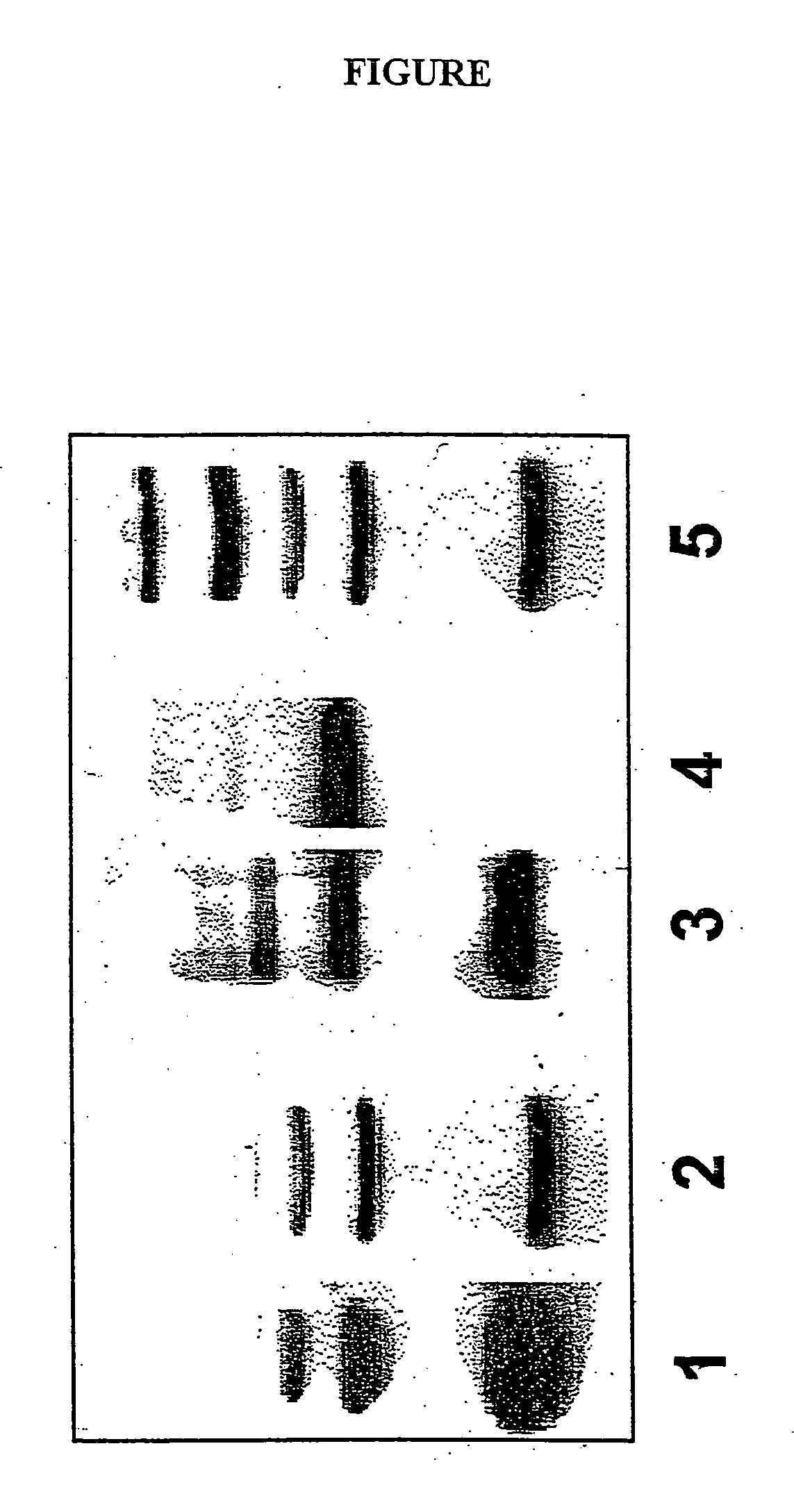Molecular weight markers for western blot
- Summary
- Abstract
- Description
- Claims
- Application Information
AI Technical Summary
Benefits of technology
Problems solved by technology
Method used
Image
Examples
Example
Example 1
˜13 to 40 kDa range (cytochrome C oligomers)
[0024] Material:
[0025] 20 mg cytochrome C
[0026] buffer A: 10 mM NaPi pH 7.4, 150 mM NaCl
[0027] buffer B: IM DL-lysine in buffer A
[0028] buffer C: 40 mM Tris-Cl pH 7.4, 300 mM NaCl
[0029] solution D: 20 mM DSS in dimethyl sulfoxide (extemporary preparation). [0030] 1. Dissolve cytochrome C in 0.18 ml of buffer A. [0031] 2. Add 0.02 ml of solution D. [0032] 3. Stir 1 h at room temperature. [0033] 4. Add 0.02 ml of buffer B.
[0034] If a set with bands having the same intensity is desired, continue with the subsequent steps, otherwise directly skip to step 7. [0035] 5. Load on a Superdex 75 column (10×300 mm) or on a column with similar characteristics, equilibrated and eluted in buffer C at a 0.5 ml / min flow rate, separately recovering the eluted peaks. [0036] 6. Mix each peak in amounts inversely proportional to the chromatographic peak area. [0037] 7. Aliquot and freeze at a temperature below −20° C.
Example
Example 2
˜60 to 130 kDa range (cytochrome C conjugates)
[0038] Material:
[0039] 1 mg cytochrome C
[0040] 3.3 mg ovalbumin
[0041] 10 mg bovine serum albumin
[0042] buffer A: 10 mM NaPi pH 7.4, 150 mM NaCl
[0043] buffer B: 1M DL-lysine in buffer A
[0044] solution D: 20 mM DSS in dimethyl sulfoxide (extemporary preparation). [0045] 1) Dissolve cytochrome C in 1 ml of buffer A. [0046] 2) Dissolve ovalbumin in 0.8 ml of buffer A and add 0.1 ml of solution from step 1. [0047] 3) Dissolve bovine serum albumin in 0.8 ml of buffer A and add 0.1 ml of solution from step 1. [0048] 4) Add 0.1 ml of solution D to the solutions prepared at steps 2 and 3. [0049] 5) Stir the solutions from step 4 for 1 h at room temperature. [0050] 6) Add 0.1 ml of buffer B. [0051] 7) Aliquot and freeze at temperature below −20° C.
Example
Example 3
˜15 to 45 kDa range (microperoxidase MP-11 conjugates)
[0052] Material:
[0053] 1 mg microperoxidase MP-11
[0054] 10 mg lysozyme
[0055] 5 mg carbonic anhydrase
[0056] buffer A: 10 mM NaPi pH 7.4, 150 mM NaCl
[0057] buffer B: 1M DL-lysine in buffer A
[0058] solution D: 20 mM DSS in dimethyl sulfoxide (extemporary preparation). [0059] 1. Dissolve microperoxidase in 1 ml of buffer A. [0060] 2. Dissolve lysozyme in 0.8 ml of buffer A and add 0.1 ml of solution from step 1. [0061] 3. Dissolve carbonic anhydrase in 0.8 ml of buffer A and add 0.1 ml of solution of step 1. [0062] 4. Add 0.1 ml of solution D to the solutions prepared at steps 2 and 3. [0063] 5. Stir the solutions from step 4 for 1 h at room temperature. [0064] 6. Add 0.1 ml of buffer B. [0065] 7. Aliquot and freeze at temperature below −20° C.
PUM
| Property | Measurement | Unit |
|---|---|---|
| Size | aaaaa | aaaaa |
| Molecular weight | aaaaa | aaaaa |
Abstract
Description
Claims
Application Information
 Login to View More
Login to View More - R&D
- Intellectual Property
- Life Sciences
- Materials
- Tech Scout
- Unparalleled Data Quality
- Higher Quality Content
- 60% Fewer Hallucinations
Browse by: Latest US Patents, China's latest patents, Technical Efficacy Thesaurus, Application Domain, Technology Topic, Popular Technical Reports.
© 2025 PatSnap. All rights reserved.Legal|Privacy policy|Modern Slavery Act Transparency Statement|Sitemap|About US| Contact US: help@patsnap.com

